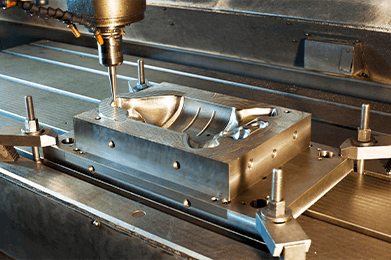Molds for Prototypes
Die Molds are both used for shaping metals, and are used to make a variety of different objects for different industries. Molds tend to be used to produce products that need to be hollow in the middle. Molds are used in injection molding such as with melted resin or casting molten metal. Molds and dies are both tools that are essential to mass production in manufacturing.
Materials for molds can include tool steels with carbon or chromium content, as well as die steel, high-speed steel, and cemented carbide. Ceramics have also been used as a material. Materials used for dies and molds can be difficult to cut. So dies and molds are cut using machining centers or other NC machining tools. The products usually go through subsequent processes such as grinding for added precision. Additionally, electrical discharge machining can be used to produce molds with greater detail. This method is capable of producing precision metalworking, and supports the creation of complex three-dimensional shapes. Molds can also be produced using CNC grinding and thread grinding.

Materials Used For Die Casting Molds:
The selection of die casting molds depends on the temperature and type of the cast metal.
Aluminum alloy die casting mold
The temperature of aluminum alloy melt is usually approximately 1202-1292℉. The mold life of aluminum alloy die casting molds should be taken into consideration. Some aluminum alloy die casting mold steels included: 4Cr5MoSiV1 (H13), 4Cr5MoSiV (H11), 3Cr2W8V, and new steel grades Y10 and HM3.
Zinc alloy die casting mold
The melting point of zinc alloy is approximately 752-806℉. The surface temperature of the zinc alloy die-casting mold cavity will not exceed 400°C. Generally, the materials generally used to manufacture zinc alloy die-casting molds are alloy structural steels 40Cr, 30CrMnSi, 40CrMo, etc., alloy mold steels 5CrNiMo, 5CrMnMo, 4Cr5MoSiV, 4Cr5MoSiV1, 3Cr2W8V, CrWMn, etc.
Magnesium alloy die casting mold
The melting point of magnesium alloy approximately 1202℉. The tensile strength of magnesium alloy castings is equivalent to that of aluminum alloy castings, up to 250Mpa to more than 600Mpa. The most commonly used is H13 steel or materials with similar properties. After machining, the cavity part is quenched and annealed to make the hardness within the range of 46-48HRC. The cavity part and special parts of the mold need to use H13 steel. These parts usually account for 20-30% of the weight of the entire mold. Other parts of the mold are made of low-carbon steel and medium-carbon steel. Molds of standardized modules are often used for smaller die cast parts with relatively simple geometric switches.
Green Oak Tool